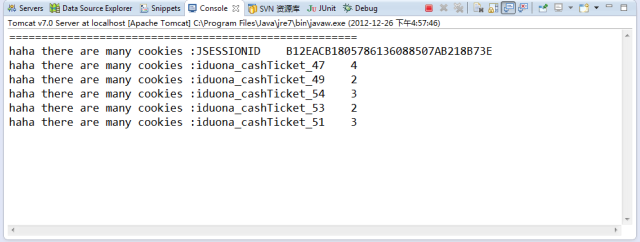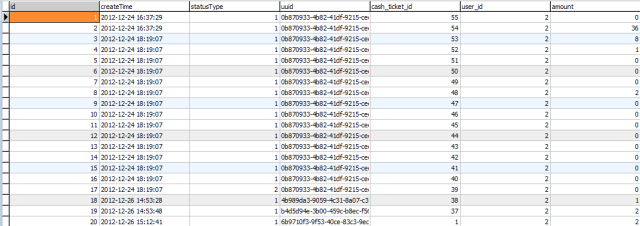java web development_shopping cart function implementation
I have never been exposed to a shopping cart before, and I don’t know how to use a shopping cart, so I checked a lot of information and summarized the functional implementation of the shopping cart.
Query information and find three methods:
1. Use cookies to implement the shopping cart;
2. Use sessions to implement the shopping cart;
3. Use cookies and databases (shopping cart information persistence) to implement the shopping cart;
================================================== =========================
Analyze the advantages and disadvantages of these three methods:
1. Simply use cookies to implement the shopping cart, like this The shopping cart is not very ideal. Imagine if the client's browser disables cookies,
This method will fail here...
Save the shopping cart information in 2.session. This is only in one session. Available in, if the user adds a shopping cart without logging in, or after logging in, after closing the browser
or logging out, all the shopping carts added before will be aborted...
3. What I want to say here This is the method...
Main process:
A. Data flow before user login: When the user adds the items he likes to the shopping cart without logging in to the system, then at this time, we can Save the shopping cart information to cookies, which will involve adding and modifying cookies; that is, if the corresponding cookie does not exist in the cookie before, the cookie will be added.
If there is a corresponding cookie in the cookie, then at this time, the cookie needs to be modified (this involves the situation where the user adds the same product to the shopping cart multiple times).
B. Data flow after the user logs in: After the user logs in, the first thing the system does is to obtain the corresponding cookies. If there are relevant shopping cart cookies, then the shopping cart
information will be processed accordingly. The persistence operation of User is either adding or modifying. (Add operation: If the shopping cart corresponding to the user does not have corresponding information, add the operation; Modify operation: Similarly,
If there is shopping cart information corresponding to the user, perform the modification operation). After the user logs in, he can also add to the shopping cart. However, instead of adding it to the cookie, it is directly persisted to the
database. Note: The data after the user logs in is dealt with the database.
================================================== =========================
Code part:
================== ================================================== =====
Note:
1 Conf.IDUONA_CASHTICKET_COOKIE_STARTNAME = "iduona_cashTicket_";
/**
* 用户登录
*
* @author hongten
*/
public void login() {
//用户登录的时候,去读取cookies,并且进行持久话操作,更多的登录操作这里省略啦....
peristShoppingCartWhenUserLogin(newUser);
}
/**
* 加入购物车<br>
* ============================================<br>
* 用户登录前:<br>
* 用户在选择现金券的时候,点击现金券的加入购物车的时候,会把该现金券的信息(现金券的id,购买数量)<br>
* 传递到这里,这时候,后台要做的就是从cookie中查询出是否有相同的记录,如果有相同的记录<br>
* 则把相应的记录更新;否则,就添加新的记录<br>
* 用户登录后:<br>
* 用户在登录后,如果有添加购物车操作,则不用保存到cookie中,而是直接持久化购物车信息<br>
*
* @throws Exception
*/
public void addToShoppingCart() throws Exception {
if (cashTicket == null || cashTicket.getId() == null || cashTicket.getId() < 1) {
write("nullId");
} else if (q == null || q == "") {
// 购买数量,默认情况下面为1
q = String.valueOf(1);
} else {
// 读取所有的cookie
Cookie cookies[] = ServletActionContext.getRequest().getCookies();
if (cookies == null || cookies.length < 0) {
// 没有cookie
System.out.println("there is no any cookie ..");
} else {
// 判断用户是否登录
if (getUserInSession() == null) {
boolean flag = true;
for (Cookie c : cookies) {
if (c.getName().equals(Conf.IDUONA_CASHTICKET_COOKIE_STARTNAME + cashTicket.getId())) {
// 说明已有的cookies中有相应的cookie,就进行更新操作
Integer oldValue = Integer.valueOf(c.getValue());
Integer newValue = Integer.valueOf(oldValue + Integer.valueOf(q));
fixCookie(c, newValue.toString().trim());
flag = false;
}
}
// 说明已有的cookies中没有相应的cookie,就进行添加操作
if (flag) {
addCookie(Conf.IDUONA_CASHTICKET_COOKIE_STARTNAME + cashTicket.getId(), q.trim());
}
// ==================================================
// 测试用,读取所有的cookies
readShoppingCartFromCookie();
// ==================================================
write("success");
} else {
// 如果用户登录,说明session存在user,这时就持久化购物车信息
CashTicket cashTicketTemp = cashTicketService.get(cashTicket.getId());
if (shoppingCartService.isExistUserAndCashTicket(getUserInSession(), cashTicketTemp)) {
ShoppingCart oldShoppingCart = shoppingCartService.getByUserAndCashTicket(getUserInSession(), cashTicketTemp);
oldShoppingCart.setAmount(oldShoppingCart.getAmount() + Integer.valueOf(q));
if (shoppingCartService.update(oldShoppingCart)) {
write("success");
}
} else {
ShoppingCart shoppingCartTemp = new ShoppingCart();
shoppingCartTemp.setAmount(Integer.valueOf(q));
shoppingCartTemp.setUser(getUserInSession());
shoppingCartTemp.setCashTicket(cashTicketTemp);
shoppingCartTemp.setCreateTime(new Date());
shoppingCartTemp.setStatusType(StatusType.POSITIVE);
shoppingCartTemp.setUuid(UUID.randomUUID().toString());
if (shoppingCartService.save(shoppingCartTemp)) {
write("success");
}
}
}
}
}
}
/**
* 从cookie中读取购物车信息
*
* @throws Exception
* @return
*/
public void readShoppingCartFromCookie() throws Exception {
System.out.println("======================================================");
Cookie cookies[] = ServletActionContext.getRequest().getCookies();
if (cookies == null || cookies.length < 0) {
// System.out.println("there is no any cookie ..");
// 没有cookie
} else {
for (Cookie c : cookies) {
System.out.println("haha there are many cookies :" + c.getName() + " " + c.getValue());
}
}
}
/**
* 添加cookie操作
*
* @param name
* cookie的name
* @param value
* cookie的value
*/
public void addCookie(String name, String value) {
Cookie cookie = new Cookie(name.trim(), value.trim());
cookie.setMaxAge(2 * 60 * 60 * 1000);// 设置为2个钟
ServletActionContext.getResponse().addCookie(cookie);
}
/**
* 更新cookie操作
*
* @param c
* 要修改的cookie
* @param value
* 修改的cookie的值
*/
public void fixCookie(Cookie c, String value) {
c.setValue(value.trim());
c.setMaxAge(2 * 60 * 60 * 1000);// 设置为2个钟
ServletActionContext.getResponse().addCookie(c);
}
/**
* 当用户登录的时候,持久化cookie中的购物车信息,更新为本用户的购物车信息
*/
public void peristShoppingCartWhenUserLogin(User user) {
if (null != user) {
Cookie cookies[] = ServletActionContext.getRequest().getCookies();
if (cookies != null) {
for (Cookie c : cookies) {
if (c.getName().startsWith(Conf.IDUONA_CASHTICKET_COOKIE_STARTNAME)) {
// 获取cookie的名称:"iduona_cashTicket_45" 和 cookie的值: "21"
String name = c.getName();
Integer amount = Integer.valueOf(Integer.valueOf(c.getValue())+Integer.valueOf(q));
Integer ct_id = Integer.valueOf(name.substring(name.lastIndexOf("_") + 1));
CashTicket temp = cashTicketService.get(ct_id);
ShoppingCart shoppingCartTemp = new ShoppingCart();
if (null != temp) {
if (shoppingCartService.isExistUserAndCashTicket(user, temp)) {
// 进行更新操作
ShoppingCart oldShoppingCart = shoppingCartService.getByUserAndCashTicket(user, temp);
oldShoppingCart.setAmount(amount);
shoppingCartService.update(oldShoppingCart);
} else {
// 否则进行保存记录
shoppingCartTemp.setAmount(amount);
shoppingCartTemp.setUser(user);
shoppingCartTemp.setCashTicket(temp);
shoppingCartTemp.setCreateTime(new Date());
shoppingCartTemp.setStatusType(StatusType.POSITIVE);
shoppingCartTemp.setUuid(UUID.randomUUID().toString());
shoppingCartService.save(shoppingCartTemp);
}
}
}
}
// 移除所有的现金券cookies
removeAllCookies();
}
}
}
/**
* 移除所有的现金券cookies操作
*/
public void removeAllCookies() {
Cookie cookies[] = ServletActionContext.getRequest().getCookies();
if (cookies == null || cookies.length < 0) {
// 没有cookie
System.out.println("there is no any cookie ..");
} else {
System.out.println("开始删除cookies..");
for (Cookie c : cookies) {
if (c.getName().startsWith(Conf.IDUONA_CASHTICKET_COOKIE_STARTNAME)) {
c.setMaxAge(0);// 设置为0
ServletActionContext.getResponse().addCookie(c);
}
}
}
}This is part of the code....
Effect:
If the user is not logged in
 user After logging in:
user After logging in:
 The situation in the database:
The situation in the database:
Data before logging in

For more articles related to java web development_shopping cart function implementation, please pay attention to PHP Chinese website!

Hot AI Tools

Undresser.AI Undress
AI-powered app for creating realistic nude photos

AI Clothes Remover
Online AI tool for removing clothes from photos.

Undress AI Tool
Undress images for free

Clothoff.io
AI clothes remover

AI Hentai Generator
Generate AI Hentai for free.

Hot Article

Hot Tools

Notepad++7.3.1
Easy-to-use and free code editor

SublimeText3 Chinese version
Chinese version, very easy to use

Zend Studio 13.0.1
Powerful PHP integrated development environment

Dreamweaver CS6
Visual web development tools

SublimeText3 Mac version
God-level code editing software (SublimeText3)

Hot Topics
 Top 4 JavaScript Frameworks in 2025: React, Angular, Vue, Svelte
Mar 07, 2025 pm 06:09 PM
Top 4 JavaScript Frameworks in 2025: React, Angular, Vue, Svelte
Mar 07, 2025 pm 06:09 PM
This article analyzes the top four JavaScript frameworks (React, Angular, Vue, Svelte) in 2025, comparing their performance, scalability, and future prospects. While all remain dominant due to strong communities and ecosystems, their relative popul
 Spring Boot SnakeYAML 2.0 CVE-2022-1471 Issue Fixed
Mar 07, 2025 pm 05:52 PM
Spring Boot SnakeYAML 2.0 CVE-2022-1471 Issue Fixed
Mar 07, 2025 pm 05:52 PM
This article addresses the CVE-2022-1471 vulnerability in SnakeYAML, a critical flaw allowing remote code execution. It details how upgrading Spring Boot applications to SnakeYAML 1.33 or later mitigates this risk, emphasizing that dependency updat
 Node.js 20: Key Performance Boosts and New Features
Mar 07, 2025 pm 06:12 PM
Node.js 20: Key Performance Boosts and New Features
Mar 07, 2025 pm 06:12 PM
Node.js 20 significantly enhances performance via V8 engine improvements, notably faster garbage collection and I/O. New features include better WebAssembly support and refined debugging tools, boosting developer productivity and application speed.
 How do I implement multi-level caching in Java applications using libraries like Caffeine or Guava Cache?
Mar 17, 2025 pm 05:44 PM
How do I implement multi-level caching in Java applications using libraries like Caffeine or Guava Cache?
Mar 17, 2025 pm 05:44 PM
The article discusses implementing multi-level caching in Java using Caffeine and Guava Cache to enhance application performance. It covers setup, integration, and performance benefits, along with configuration and eviction policy management best pra
 How does Java's classloading mechanism work, including different classloaders and their delegation models?
Mar 17, 2025 pm 05:35 PM
How does Java's classloading mechanism work, including different classloaders and their delegation models?
Mar 17, 2025 pm 05:35 PM
Java's classloading involves loading, linking, and initializing classes using a hierarchical system with Bootstrap, Extension, and Application classloaders. The parent delegation model ensures core classes are loaded first, affecting custom class loa
 How to Share Data Between Steps in Cucumber
Mar 07, 2025 pm 05:55 PM
How to Share Data Between Steps in Cucumber
Mar 07, 2025 pm 05:55 PM
This article explores methods for sharing data between Cucumber steps, comparing scenario context, global variables, argument passing, and data structures. It emphasizes best practices for maintainability, including concise context use, descriptive
 Iceberg: The Future of Data Lake Tables
Mar 07, 2025 pm 06:31 PM
Iceberg: The Future of Data Lake Tables
Mar 07, 2025 pm 06:31 PM
Iceberg, an open table format for large analytical datasets, improves data lake performance and scalability. It addresses limitations of Parquet/ORC through internal metadata management, enabling efficient schema evolution, time travel, concurrent w
 How can I implement functional programming techniques in Java?
Mar 11, 2025 pm 05:51 PM
How can I implement functional programming techniques in Java?
Mar 11, 2025 pm 05:51 PM
This article explores integrating functional programming into Java using lambda expressions, Streams API, method references, and Optional. It highlights benefits like improved code readability and maintainability through conciseness and immutability






